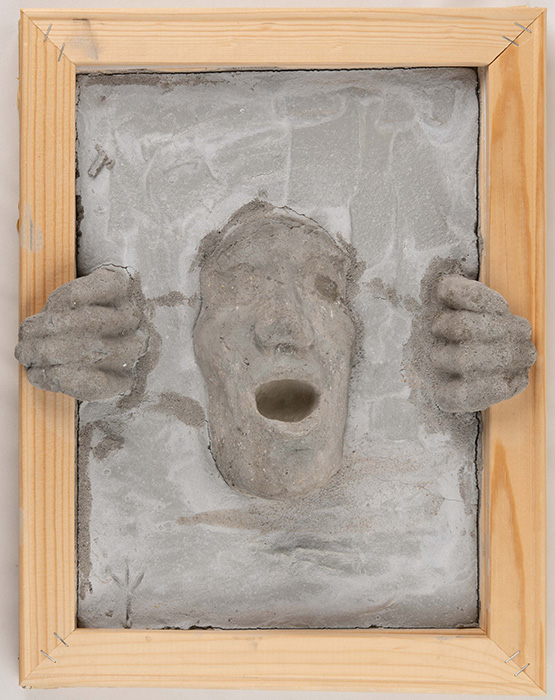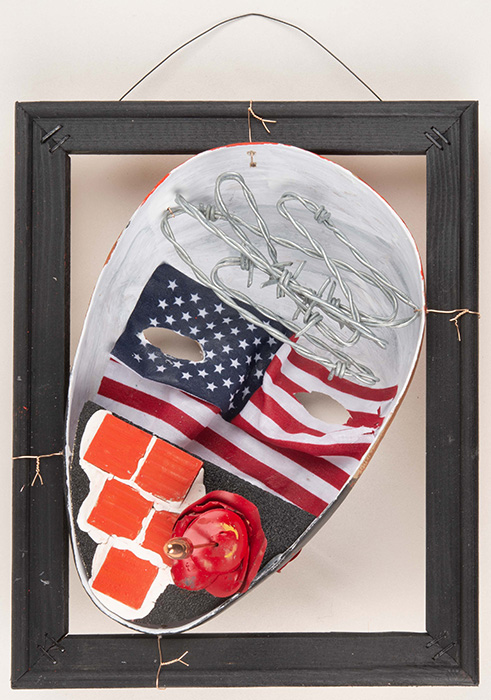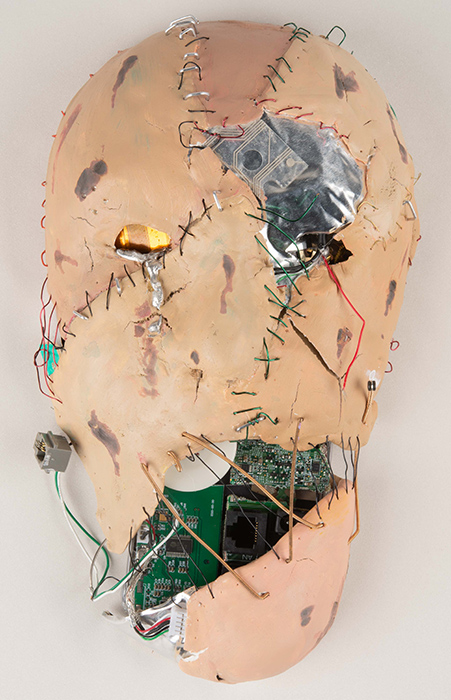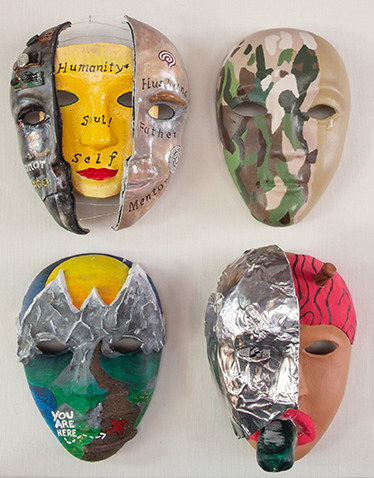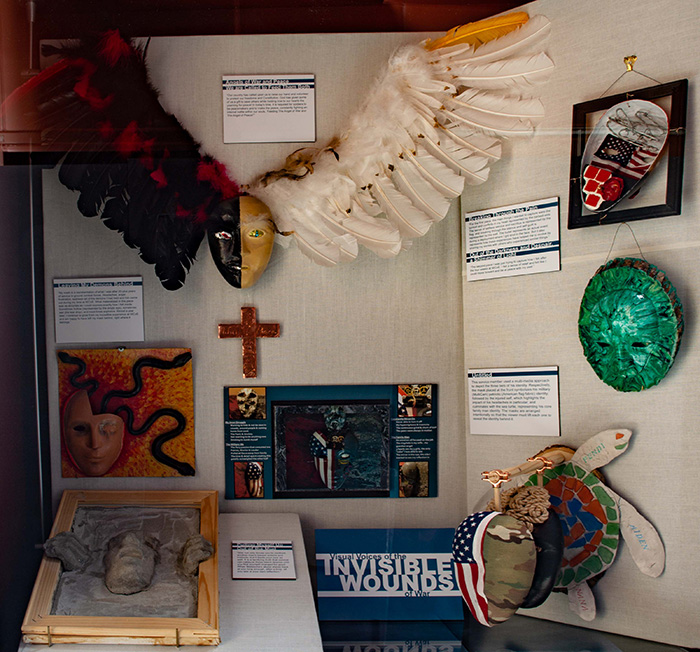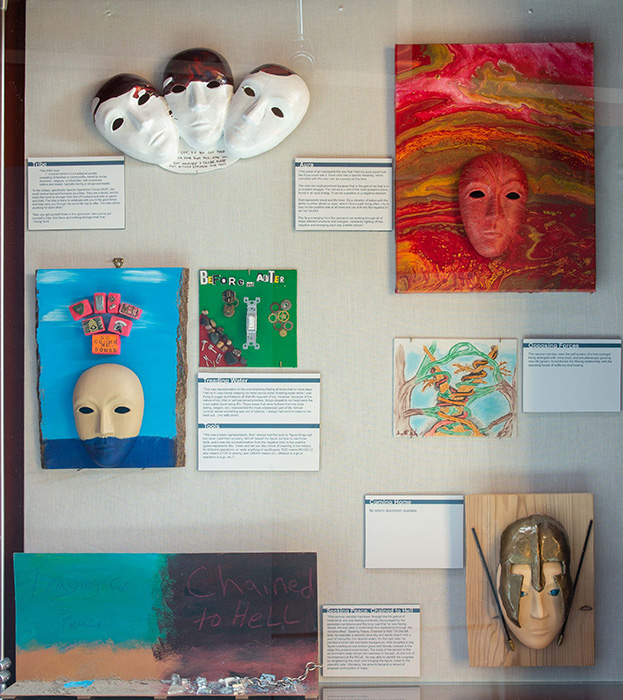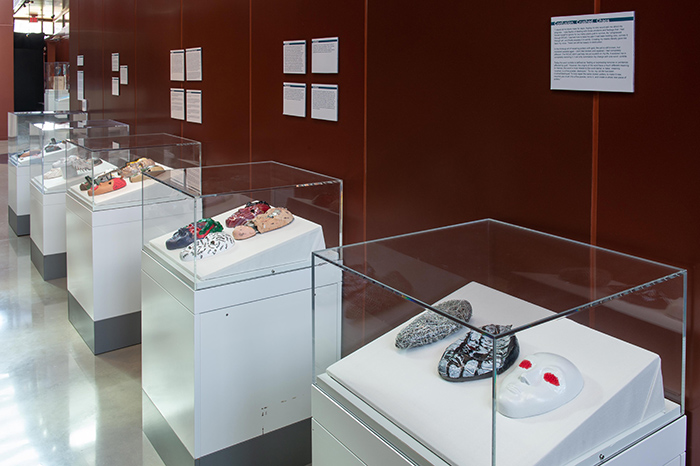Medical Museum Commences Brain Injury Awareness Month with Mask-Making Arts Therapy Exhibit in Collaboration with the National Intrepid Center of Excellence
By Jacqueline Gase
NMHM Public Affairs Coordinator
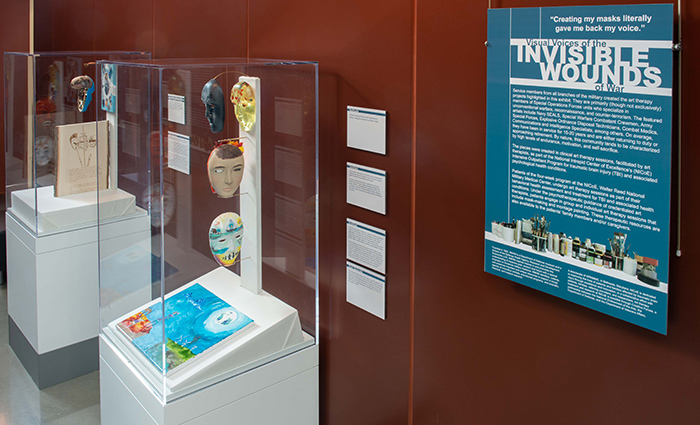
Masks, a wooden plaque, and a montage painting made by patients in the Creative Arts Therapy Program at the National Intrepid Center of Excellence at Walter Reed National Military Medical Center are displayed in cases in the National Museum of Health and Medicine's March 8 to May 31, 2019 art therapy exhibit titled "Visual Voices of the Invisible Wounds of War" in Silver Spring, Maryland. (Disclosure: This image has been cropped to emphasize the subject.) (Department of Defense photo by Matthew Breitbart/ Released)
In acknowledgement of Brain Injury Awareness Month, the National Museum of Health and Medicine (NMHM), in collaboration with the National Intrepid Center of Excellence (NICoE) at Walter Reed National Military Medical Center (WRNMMC), opened "Visual Voices of the Invisible Wounds of War," an exhibit about art therapy for patients and family members impacted by traumatic brain injury (TBI) and associated health conditions. Centering on mask-making, a clinical art therapy directive, the current exhibit explores the psychosocial environment of patients with TBI and how producing masks that express their emotional state can help them reach a positive understanding of their identity.
TBI is a complex brain dysfunction that usually results from a violent blow or jolt to the head. At the NICoE, doctors, researchers, and therapists work in a collaborative clinical setting with families, caregivers and referring providers to help service members manage their TBI symptoms and psychological health, enhancing their well-being long-term. Through a comprehensive four-week Intensive Outpatient Program (IOP), the NICoE delivers tailored treatment plans that focus on the mind, body and spirit, addressing the unique needs of their patient population. Patients of the IOP undergo art therapy sessions as part of their behavioral health assessment and treatment for TBI. Art therapy sessions are part of the NICoE's Healing Arts Program which focuses on improving patients' quality of life through the creative arts therapies (art, music, dance/movement) and writing.
The NICoE at WRNMMC is the pilot location of Creative Forces: NEA Military Healing Arts Network, a partnership of the National Endowment of the Arts, the Departments of Defense, and Veterans Affairs, that has since expanded to provide creative arts therapies at the core of patient-centered care at 11 clinical sites throughout the country, plus a telehealth program. Melissa Walker, Healing Arts Program Coordinator at the NICoE, reports the success of art therapy for patients with TBI, when used as part of a comprehensive treatment plan.
Walker states, "It's very powerful; there's a lot of benefit. One of the [former] director's favorite things to say is the creative art therapies are less than one percent of our operating budget, but they're listed time and time again with the service members' self-report as the top five treatments they would hope to be able to continue when they go back home [leave NICoE care]."
As Walker emphasized, art therapy gives service members the opportunity to open up about their experiences and the way they've felt since being injured. "We, the art therapists, are trained to process with them psychotherapeutically as they create symbolism and metaphor in their artwork," explains Walker. The products the service members create can be an emotional scenario. "They've created something that's very meaningful…it could be a memorial, it could be a memory…sometimes it's symbols of who they are in the military, a character, or a nickname," states Walker. As a therapeutic process, these symbols help the service members come to terms with their trauma and to understand their identity.
The art therapy treatment at the NICoE can also provide a type of therapy to the families. Since communication is crucial to a patient's recovery, mask-making can convey sentiments that are otherwise difficult for the patient to communicate. In the fourth week of treatment at the NICoE, families join the service members. "We've seen art therapy products be talking pieces for them. It really helps to communicate to their spouses and children how they are feeling. We've seen a lot of families look at the product and say 'oh, I've never completely understood before, but now I can see,'" says Walker. Through this artistic object, the audience can try to understand, to a certain extent, the patient's trauma. Families, with their newfound awareness, can better grasp the problems that overwhelm patients of TBI and then provide proper support.
As the focal point for NMHM's "Visual Voices of the Invisible Wounds of War," decorating papier-mâché masks is one of the directives used in art therapy that enables TBI patients at the NICoE to examine their identity and trauma through art. Adrienne Stamper, art therapist at the NICoE through Creative Forces, was a guiding force in helping to curate the show.
Stamper was responsible for reaching out to past service members, patients she and Walker engaged with in art therapy treatment at the NICoE, for approval to exhibit their work. Stamper received positive responses almost 100 percent of the time. Walker states that for this type of community, "sense of purpose is important, and I think them knowing they are giving back and letting other service members and veterans know that this is a beneficial form of treatment, they feel excited about that. It also validates their experiences."
In the exhibit, some masks are paired with a label provided by the patient responding to the work. The mask titled "Breaking Through the Pain" is part one of a two-part series. The interior of the mask is a mixed-media product designed with barbed wire, a painted flag and wall, and a bullet. The service member who crafted the mask notes that the main things he wanted to capture were the turmoil and conflict in his head, his sense of selfless service, his breakthroughs from his silence and self-guilt, and an actual event where he was shot in the face. For this service member, the mask-making treatment empowered him to share his stories with others with similar experiences. It's a visual vocalization of his trauma and shared identity.
"Hosting the masks provides a temporary home for these deeply personal expressions. We ask our visitors to consider them not merely as mute art objects, but as clear images of the healing process, or the challenges of contending with life-altering experiences," comments Dr. Adrianne Noe, Ph.D., director of NMHM.
The mask discussed previously, and other masks and mixed-media artwork will be on display at NMHM during Brain Injury Awareness Month starting March 8, and the exhibit will remain open until May 31.
NMHM's exhibits provide forums for conversation that connect the mission of the Department of Defense museum with the public. NMHM was founded as the Army Medical Museum in 1862 and is a division of the Defense Health Agency Research and Development Directorate. For more information about upcoming events, call (301) 319-3303 or visit https://www.medicalmuseum.mil.




